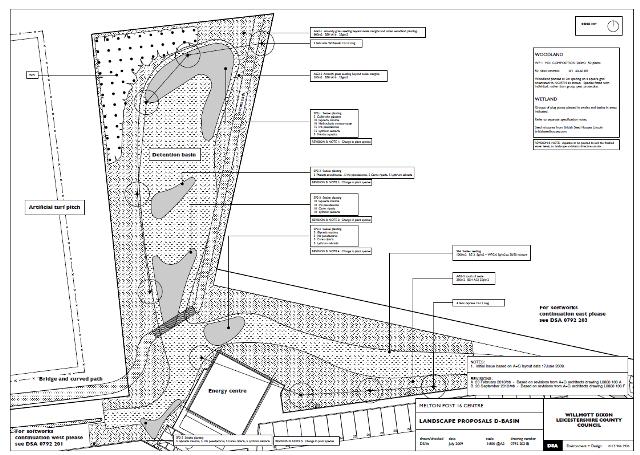

SuDS-related links
Keeping ahead
with SuDS
Attend SuDS training to keep ahead of the competition and to deliver innovative solutions in line with recognised good practice.
home > using SuDS > case studies > Melton, Mowbray
Burton Road, south of Melton Mowbray town centre, Leicestershire.
Fig 1:location of Melton (click on image to enlarge) |
The Post-16 Centre is a new school catering for Post-16 Students from the Melton Mowbray area. It sits on the site of the demolished Sarsen School, on the King Edward VII school campus. The building is served by car parking for both staff and students, with a number of smaller ancillary buildings for storage and plant. The site lies at roughly 106mAOD on a plateau surrounded by playing fields. The whole site is around 2.9ha. Surface water drainage flows to a Severn Trent Water open channel to the north.
.jpg) |
 |
|---|---|
Fig 2:Master plan (click on image to enlarge) |
Fig 3: Landscape design (click on image to enlarge) |
Main SuDS usedThe concept of a SuDS ‘treatment train’ has been employed. The building location was adjusted to enable an almost totally ‘above ground’ solution. Some limited underground drainage was used, such as to connect under heavily trafficked areas. It was felt that, being a college site, with a great many students close to the building envelope, that rainwater downpipes had to be taken underground initially rather than discharging directly into swales. The Environment Agency requested the imposition of a condition requiring a landscape management plan (LMP) for the site.
|
Fig 4:Swale The new swales at the eastern side of the site with grass establishing in January 2011.
Wild flower grass seeding is programmed to take place in spring. |
A swale system carries water from hard surfaces via ‘nested wetlands’ to a main dry detention basin. Bio-swales are very shallow and have carefully graded side slopes to enable mowing. As far as possible, the swales include a narrow filter strip which will provide some pre-treatment. Longitudinal sections were adjusted in fine detail on site to enable wetter areas to ‘pond’ water and allow intermediate development of taller marginal species. The swales discharge to a detention basin, thus providing two treatment-train or treatment stage components.
Runoff from other hard surfaces is collected by more traditional techniques, such as gullies and linear drains. This system includes a secondary an additional dry detention basin. This contains a sediment forebay with upper and lower levels separated by gabion baskets and earth forms, which will encourage settlement. Water is then directed to the main basin. Runoff from roof areas is directed to a rainwater harvesting tank, prior to discharging to the main basin.
|
|
|---|---|
Fig 5: The main detention basin showing the elevated ‘sedge shelf’ close to the new pedestrian bridge in October 2010. |
Fig 6: The main detention basin with the new pedestrian bridge installed in January 2011. This allows staff and students close contact with the water system, and an elevated view of the basin and sedge shelf. |
The soils on site are predominantly clay. These have been heavily re-worked as part of the development. Soil-water infiltration is made possible by shallow gradient, unlined swales and detention basins, though the amount is expected to be low. The scheme was designed to not flood for a 1 in 100 year return period rainfall event, plus an allowance for climate change. Water exits the site via a gabion headwall in the dry detention basin, which in turn directs water to a Severn Trent Water open channel in the north. The discharge rate is controlled by means of an orifice plate. Planting was modified to cope with wetter than anticipated conditions.
Design and constructionTeam: |
Fig 7: Swale - The curvilinear form to the swale system, combined with ground modelling and planting, creates a series of outdoor spaces to be used for teaching. |
Support from Leicestershire County Council Planning and Environment Agency.
LCC planning had experienced success of a number of SuDS schemes in schools.
EA consultation via LCC requested a SuDS solution with an LMP. This was passed on to the team and conditioned.
Officer contact: Planning Case Officer. Leicestershire County Council Steve Marriott.